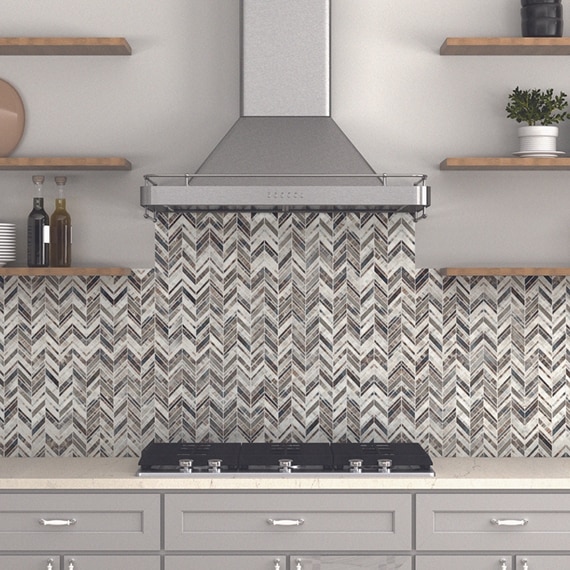
Ceramic Tile Care Instructions
ROUTINE CARE
Glazed tile products should be cleaned routinely with an all-purpose, low VOC, household or commercial cleaner. The product chosen should also be grout joint cleaning compatible. The type of product may vary depending on the tile application and use. A multipurpose spray cleaner, which removes soap scum, hard water deposits and mildew designed for everyday use can be used on wall tile areas in residential baths and showers. A cotton mop, cloth, sponge, or non-metallic brush should be used to apply and agitate cleaner. Rinse the area with clean water and dry thoroughly. Routine cleaners should never contain harsh chemicals as these can damage tile. Acids can damage grout and the glazed surface of the tile. Ammonia can discolor grout.Regular dust mopping, sweeping, or vacuuming is recommended prior to cleaning with liquid products.
Unglazed tile should be cleaned routinely with concentrated tile cleaners with a neutral pH for safe regular use. These cleaners are better suited for removing grease, oils, and normal spills from unglazed products. Again, these products will vary depending on the application, amount of traffic and the use. The product chosen should also be compatible with the grout.
REMOVAL OF SEALERS, WAXES, FLOOR FINISHES
Ceramic tile can be sealed if desired. It is recommended that grout be sealed.If you need to remove a topical sealer or floor wax from a ceramic tile you should use a tile sealer and adhesive remover. Always test a small area first. Apply a liberal amount of undiluted sealer & adhesive remover to a manageable area. Allow it to set without drying until coating or residue softens. Reapply if necessary until sealer softens and can be removed. If necessary, agitate with white nylon scrub pad. Wipe up the residue with a cotton towel or sponge. Rinse thoroughly with clean water. Do not use ceramic sealer removers on natural stone products.
GROUT CARE
Grout is the material used to fill the spaces between the individual tiles. Grout comes in many colors. While color is important to the final finished look of the tile installation, it has little effect on the functionality of the grout. The purpose of grout is, simply, to fill the joint between the tiles and becomes a permanent, integral component of the finished installation. Grout darkens over time, so we recommend that it be sealed regularly to preserve and protect it. Grout can be stained to normalize the color of older grout.
GROUT INSTALLATION
Immediately after tile has been installed and grouted, the new installation should be covered with brown paper to protect it from debris during the remaining construction process. The grout joints should be dampened daily with water using a clean sponge or mop during the first seven days. This procedure facilitates the grout cure and color lock. The paper will allow for two important things: (1) to protect the newly installed tile grout and (2) to allow moisture to escape from the grout as it cures, further protecting the look and utility of the floor. This is an important step in achieving color consistency. Never use plastic or non-absorbent materials to protect freshly installed tile. These types of non-absorbent products will trap moisture, causing the grout to discolor during the curing period. The protective brown paper should remain until construction is complete and the floor is opened for intended (post-construction) use.
Following a curing period of at least 24 hours, grout haze can be removed with plain water or a grout haze remover, which usually contains Sulfamic acid. Sulfamic acid can also be purchased in powder form and mixed with water to different strengths by qualified professionals.
Similarly, epoxy grout haze can be removed with an epoxy haze remover. These removers are formulated to safely and quickly remove cured epoxy haze from new tile installations. Their unique formulation will soften most epoxy hazes for easy removal without damaging the grout or tile, usually in one application. Sulfamic acid or grout removers should never be used on natural stone products.
PENETRATING/IMPREGNATING SEALER
Most tile installations use cementitious grouts. This type of grout should be sealed after installation to prevent it from staining. The grout should be sealed with a penetrating/impregnating sealer (often called grout sealers), which does not contain silicone, as silicone can shorten the useful life of the sealer. Epoxy grouts, conversely, are chemically cured and acid resistant, and as a result, do not require a sealer. The application of a good quality penetrating/impregnating sealer into the grout joints of a cementitious grout will not change the natural color of the grout, but will prevent the penetration of moisture, simplify maintenance, and help prevent staining or discoloration. Only the grout needs to be sealed, it is not required for glazed tiles to be sealed. Grout can be sealed 72 hours after installation.There are different grades of penetrating/impregnating sealers. Be sure you are aware of the life-span of your sealer. You may need to reapply the sealer on an annual basis depending on the sealer quality, traffic patterns, and maintenance routine. Some sealers have multiple year warranties. Refer to the manufacturer warranty, technical & product information for specific details on product installation, useful life, and product applications (including any warnings) before use.
GROUT MAINTENANCE
Neither sealing the grout nor using an epoxy grout will guarantee against surface buildup or discoloration of the grout. Grout needs to be cleaned on a periodic basis to remove any surface buildup. Routine grout cleaning can be done with a daily concentrated household or commercial cleaner depending on the application. When heavy-duty grout cleaning is required, you will need to use a professional strength tile and grout cleaner that can remove grease, soap scum, body oil, mildew stains, algae, and synthetic or acrylic waxes from the grout joints. However, such a product should contain non-polluting chemicals and low VOC levels. This type of product can be purchased from most home centers, or through your local professional floor covering dealer.
GROUT COLOR RESTORATION
When grout has been stained to the point that it cannot be maintained or returned to its natural color, you can return the grout back to its original color or any other color using a grout stain. Grout stains are epoxy-based products that are specifically designed to penetrate the grout and seal the surface with a permanent color. Once the grout has been stained there is no need to seal it any further with a penetrating/impregnating sealer. Prior to staining, the grout joint should be cleaned thoroughly to remove any dirt, oils, grease, or sealers with a professional strength tile and grout cleaner.DISCLAIMER
CARE AND MAINTENANCE GUIDE
American Olean does not manufacture installation products or countertop cleaning/maintenance products. American Olean provides the information on this page to its customers as an information source only. Please contact an installation product manufacturer directly, PRIOR to usage, to obtain proper handling instructions, application instruction and warnings concerning potential health hazards for any product contemplated for use.
To ensure your natural stone products will provide you with a lifetime of beauty and utility, proper maintenance is crucial. Natural stone products are porous by nature and require a different maintenance program than traditional ceramic tile. American Oleanalso strongly recommends testing a small area PRIOR to usage of any installation/countertop cleaning/maintenance product to determine whether the product serves its intended purpose.
SAFETY PRECAUTION TO CUSTOMERS
The products described in this document may have chemicals that cause reactions in certain individuals. American Oleanstrongly recommends the use of safety glasses, respirators (masks) and gloves in handling any materials that contain chemicals. American Olean recommends the proper disposal of any scrap tile/stone, installation and/or maintenance products discussed herein.
Natural stone has unique qualities that not only distinguish it from man-made materials, but also should be considered in selecting it for a particular project. Stone is not manufactured; it is a product of nature. Blocks are removed from the quarry, slabs are cut from these blocks, and the slabs are further fabricated into the final stone to be installed. Each block is different; each slab is different. Skillful blending or matching of the dimension stone blocks, veneer panels, tops, etc., results in a beautiful blending of nature’s variety and man’s design. “Uniformity of material,” when applied to natural stone, is a term of relative value that needs to be understood when making a selection.





